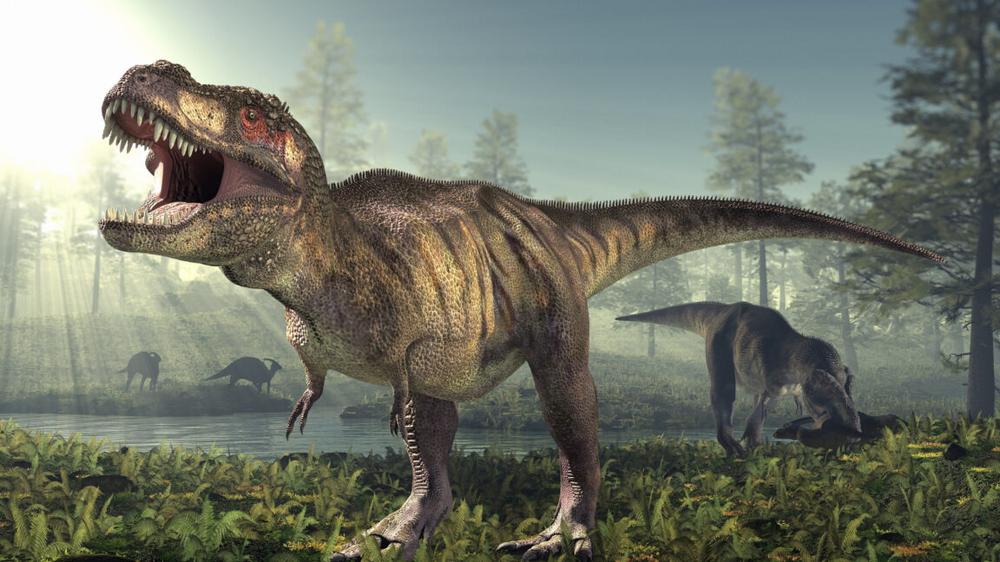When a Spinosaurus attacked a T. rex in Jurassic Park III, both giant carnivores tried to finish the fight with one powerful bite of their bone-crushing jaws. The Spinosaurus won, because when the movie was being made back in the early 2000s, fossil discoveries suggested it was the largest carnivorous dinosaur that ever lived. But new research provides evidence that size and weight didn’t always create a powerful bite.
“The Spinosaurus and the T. rex didn’t live at the same time at the same continent, but if they did, I don’t really see the Spinosaurus winning,” says Andre Rowe, a paleobiologist at the University of Bristol. He led a study analyzing the biomechanics of skulls belonging to the largest carnivorous dinosaurs. Based on his findings, T. rex was most likely was the apex predator we’ve always believed it to be. The story of other giant carnivorous dinosaurs, though, was a bit more complicated.
Staring down the giants
“Of the giant carnivore dinosaurs, T. rex is the one we know the most about because it has a pretty good fossil record,” Rowe says. There are many complete skulls which have already been scanned and analyzed, and this is how we know the T. rex had an extremely high bite force—one of the highest known in the animal kingdom. We have far fewer fossil records of other giant carnivores like Spinosaurus or Allosaurus, so we assumed they were similar to T. rex.
“There was this underlying assumption that they were all doing similar things, even though they were not closely related, and they didn't live in the same areas,” Rowe says. So, he wanted to test if those underlying assumptions were true.
One problem he faced is that the fossil records of less well-known carnivore dinosaurs had been documented with outdated technology—mostly photographs and 2D images. Rowe wanted to have accurate 3D models, so he took a handheld 3D scanner and set off on a trip to various museums to build digital models of the skulls of 18 different dinosaur carnivores, sometimes scanning individual bones. Then he pieced those scans together, like a 3D jigsaw puzzle.
Even on sight, the skulls appeared like they weren’t built for T. rex-style hunting strategy. “When you look at a T. rex skull head-on, you see it’s about as wide as it is tall—a really interesting looking animal,” Rowe says. “Skulls of Spinosaurus or Giganotosaurus were just very skinny—deceptively so.”
To understand the consequences of these differences, he took all the 3D models and explored them using finite element analysis, a computer-based method for predicting how physical objects behave under various conditions. This helped him determine how much stress each of the skulls could take when a given muscle force was applied to them. And it turned out pulling off T. rex-style bone-crushing bites would leave most of them severely damaged.
Jacks of all trades
The skulls of the dinosaurs belonging the Allosauroidea lineage—which includes Jurassic carnivores like an Allosaurus and the late Cretaceous Giganotosaurus that weighed up to eight tons—employed what Rowe calls “low stress, low power strategy.” They had skulls more susceptible to high stress due to flexibility in their joints and jaws compared to a T. rex.
“We can compare them to big lizards like Komodo Dragons. They had sort of these slicing bites, hacking away flesh off prey,” Rowe explains. Falling victim to an Allosaurus attack would probably end in a death by a thousand cuts, each delivered with low power, exerting low stress on the relatively fragile skull of the attacker.
“And then you have the Spinosaurus which was kind of weird in general,” Rowe says. “There was a study by Dave Hone and Tom Holtz about how it was waiting on the shorelines, waiting for food to go by that it could fish out.” But Spinosaurus’ foraging wasn’t limited to fishing. There was a pterosaur found preserved in its stomach and there were iguanodon remains found in the maw of a Baryonyx, another large carnivore belonging to the same lineage as the Spinosaurus. “They had great diversity in their diet. They were generalists, but our results show they weren’t these massive bone-crunching predators like the T. rex,” Rowe says. Because the T. rex was just built different.
King of the Cretaceous jungle
The Tyranosauroidea lineage had stiff, akinetic skulls, meaning they had very little mobility in the joints. The T. rex skull could and most likely did withstand very high stress as the animal pursued a “high stress, high power” strategy, entirely different from other large carnivores. “They were very much like big crocodiles with extremely strong, reinforced jaws and powerful muscles that could pulverize bones,” Rowe claims.
The T. rex, he argued, was a specialist—an ambush predator that attacked large, highly mobile prey, aiming to subdue it with a single bite. “And we have fossil evidence of that,” Rowe says. “In the Museum of Natural History in New York, there is a Hadrosaur, a large herbivorous dinosaur with a duck-like beak, and there’s a T. rex tooth embedded in its back.” This, he thinks, means the T. rex was actively preying on this animal, especially since there are healing marks around the stuck tooth. “Even with this super strong bite, the T. rex wasn’t always successful,” Rowe adds.
Still, the fight with the Spinosaurus most likely wouldn’t go the way it did in Jurassic Park III. “The T. rex was built to fight like that; the Spinosaurus really wasn’t”, Rowe says.
Current Biology, 2025. DOI: 10.1016/j.cub.2025.06.051

 “You REALLY need to call the airline”: Woman stays in Paris hotel crawling with bedbugs, then flies home
“You REALLY need to call the airline”: Woman stays in Paris hotel crawling with bedbugs, then flies home